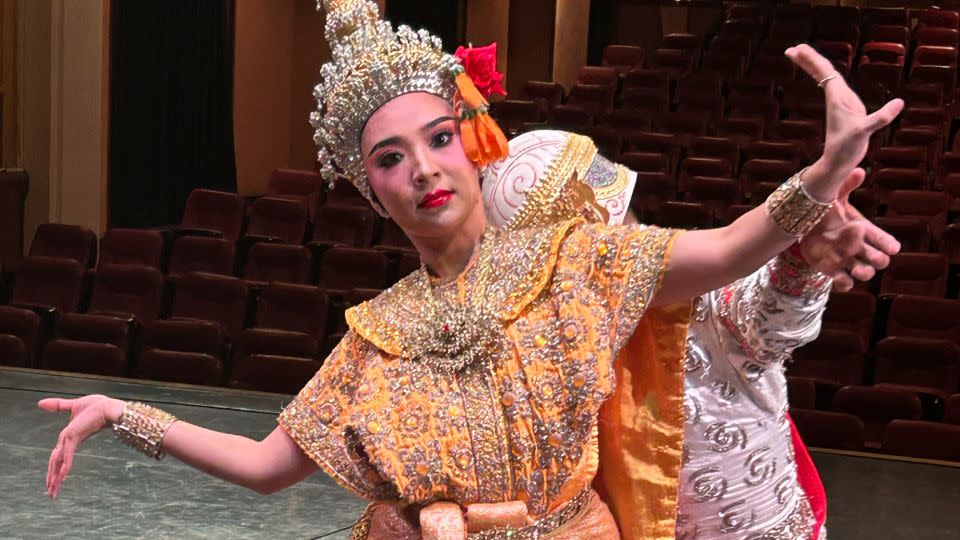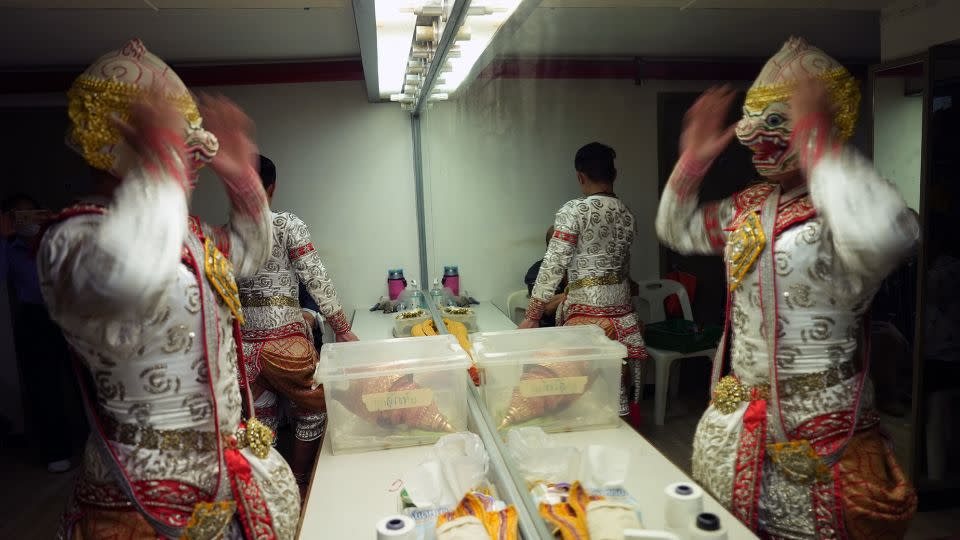Inside a historic Bangkok theater, passionate performers keep a masked art form alive
Editor’s Note: This CNN Travel series is, or was, sponsored by the country it highlights. CNN retains full editorial control over subject matter, reporting and frequency of the articles and videos within the sponsorship, in compliance with our policy.
When it comes to traditional performing arts in Thailand, Khon is perhaps the most famous of them all.
It’s highly likely visitors have encountered the characters of the country’s famed “masked drama” at some point during their travels without even realizing it.
At Suvarnabhumi International Airport in Bangkok, for instance, large statues of yak, or giant ogres, tower over departing passengers.
These giants are among the many colorful characters that appear in the Ramakien, a national Thai epic based on the Hindu tale of Ramayana. And Khon, dating back to the Ayutthaya era (1351–1767), brings the many stories of this classic piece of literature to life by combining dance, martial arts and traditional Thai music with exquisite costumes and jewelry, earning it a spot on UNESCO’s Intangible Cultural Heritage of Humanity list in 2018.
Backstage at Sala Chalermkrung Royal Theatre
In Khon, there are a few groups of characters but the main ones are the “Phra” (lords), the “Nang” (ladies), those aforementioned “Yak” (ogres), and the “Ling” (monkeys). The monkey and ogre performers all wear masks, while the other characters accentuate their facial features with dramatic, bold makeup. (Dialogue is voiced by a narrator, who is unseen during the performance.)
These days, Khon is performed everywhere from schools to special events, and even in tourist-frequented Thai restaurants. But one of the best places to experience an authentic Khon performance is Bangkok’s Sala Chalermkrung Royal Theatre.
On a recent visit to this historic space, which hosts three shows per day, five days a week, CNN headed backstage to speak with the Khon performers and find out about the challenges of keeping this art form alive in modern times.

The two main leads of this particular Khon show, who play Hanuman (the Monkey King) and the Princess Mermaid (Suvannamaccha), must arrive several hours early to prepare for the day’s three performances. (See them perform together in the above video.)
Apassara Nok-ork, 35, plays the role of the mermaid, or golden fish, who tries to wreck Hanuman’s plans to build a bridge across the sea. Plot twist: She falls in love with him instead.
As she applies heavy, detailed makeup to her face, Apassara tells CNN she has been studying traditional Thai dance since she was around four years old, choosing to focus on Khon from the age of 15.
“We have to start it at a very young age,” she says. “And we have to keep practicing the routine, and keep training our body to maintain our strength, since the costume is really heavy. While we perform, if we didn’t have enough training, our exhaustion will show and the audience would see it.”
Among the most important skills a Khon performer must possess is flexibility. Even the hand movements the female dancers carry out on stage are highly unnatural, the result of years of intense training.
When asked to demonstrate her own flexibility, Apassara grasps the four fingers of her left hand at the tips, pulling them back with her right hand, her wrist joint bending back to a position that would debilitate most.
She says the training required to get to this skill level tends to weed out those who aren’t truly passionate about the art.
“People who don’t have enough physical and mental strength, they may just quit in the middle of the studies,” she says.
When Apassara gets on stage for the first show of the day at Sala Chalermkrung, not a hint of tiredness can be seen on her face. In spite of the weight of the metallic headpiece – its strap pulled tightly across her chin – and the masses of golden fabric that envelop her body, she moves effortlessly across the stage, evading the chasing Hanuman until they meet for a beautiful duet.
For Apassara, all of the pain and hard work over the years has been worth it.
“Khon has taken me to perform at grand ceremonies including royal events, it also has taken me to faraway places – I have traveled all over the world,” she says.
“I feel proud every time I am able to present this valuable art to audiences. I still feel excited every single time I perform, no matter how many times I have done it before.”
Behind the mask with Hanuman

The masks worn by those playing the roles of giants and monkeys vary depending on the character’s status and rank, and can take weeks and even months for skilled artisans to create.
Many of the masked characters also need to be sewn into their costumes for the perfect fit – zippers and buttons simply won’t do the trick.
That includes Hanuman, the Monkey King. Among the performers tasked with playing that role at Sala Chalermkrung is 34-year-old Thanet Pakwisath, who has been practicing Khon for more than 20 years.
He tells CNN the acrobatics that the monkey must perform, including leaps and summersaults, requires incredible strength and constant training – a commitment he is happy to make.
“Khon is more than my life now,” he says. “And I believe that other performers here at Sala Chalermkrung would have the same belief.”
But like many of his colleagues, he fears for its fate.
“I want people to pay attention to Khon more, because I don’t know if it will disappear in the future or people may not care about it anymore,” says Thanet.
“Currently, there is only a small group of people who are preserving it. I want everyone to help – both Thai people and foreigners.”
Sala Chalermkrung: A living museum
Bangkok’s Sala Chalermkrung Royal Theater has its own fascinating back story. Located on historic Charoenkrung Road – Bangkok’s first paved street – it celebrated its 90th anniversary in 2023.
Sponsored by King Prajadhipok to celebrate the 150th anniversary of the founding of Bangkok, upon opening in 1933 it gave locals a chance to experience films with sound – most of them foreign movies dubbed in Thai – in a modernist, high-tech building with air conditioning.
It wasn’t until after World War II that Thai film really flourished – and so did the cinema. Sala Chalermkrung became synonymous with film openings, its premieres attended by movie stars among other Thai celebrities.
But from the late 1970s, visitors to Sala Chalermkrung began to decline. When the 1990s rolled around, it was time to make a change.
Following a series of renovations, it reopened with a new purpose: To showcase and preserve Khon, along with other classic Thai performing arts. Thankfully, the building’s original charms have been retained, from the lobby to the theater itself.
These days, the shows at Sala Chalermkrung are rotated periodically, with staff telling CNN a new Khon performance will be introduced in July. Visitors can buy a ticket at the door for 400 baht ($11) however, admission to the nearby Grand Palace (500 baht) includes a free pass to one of the theater’s weekday Khon performances, which take place at 1 p.m., 2:30 p.m. and 4 p.m.
Sala Chalermkrung Royal Theater, 66 Sala Chalermkrung, Charoenkrung Road, Phra Nakhon District, Bangkok; +66 (0)2 224 4499
For more CNN news and newsletters create an account at CNN.com

